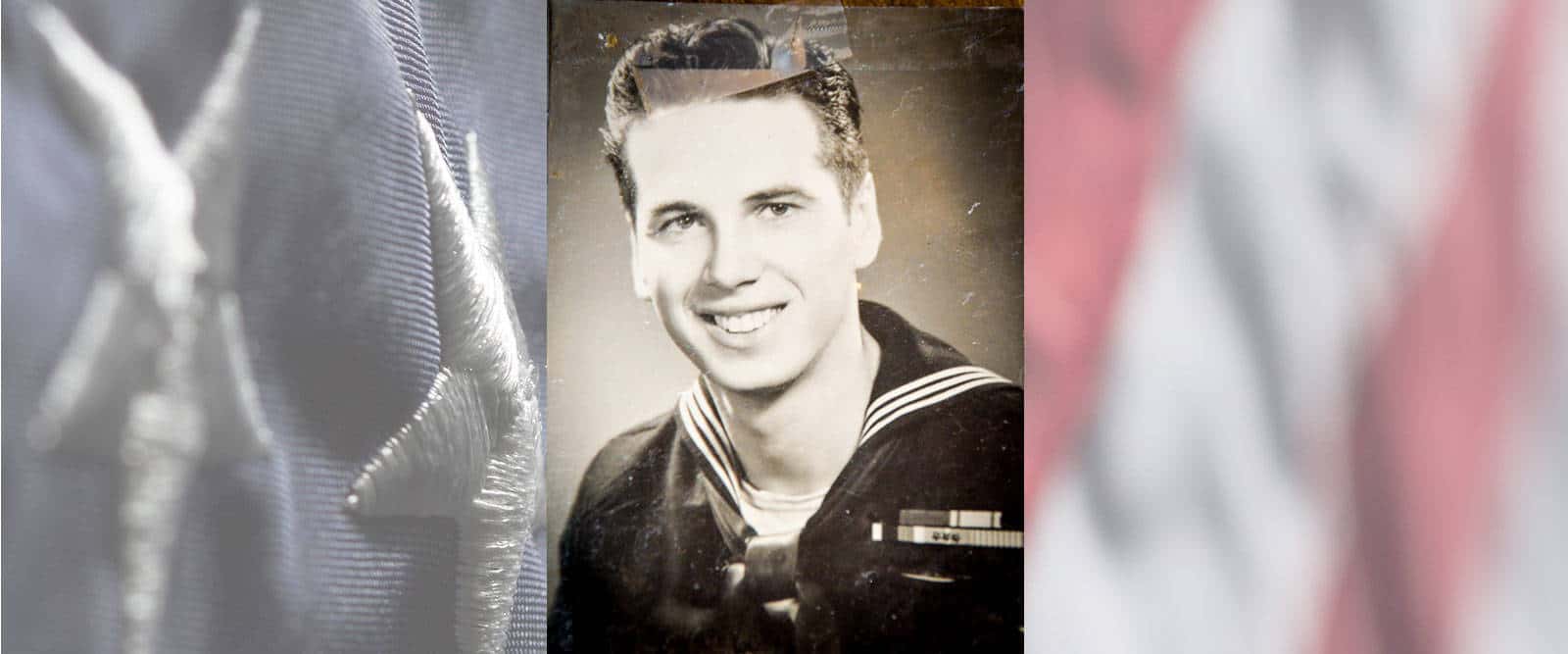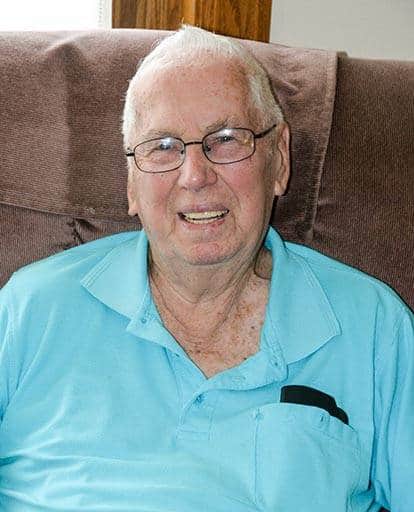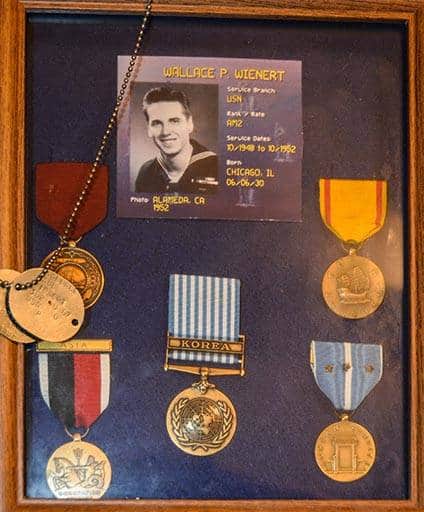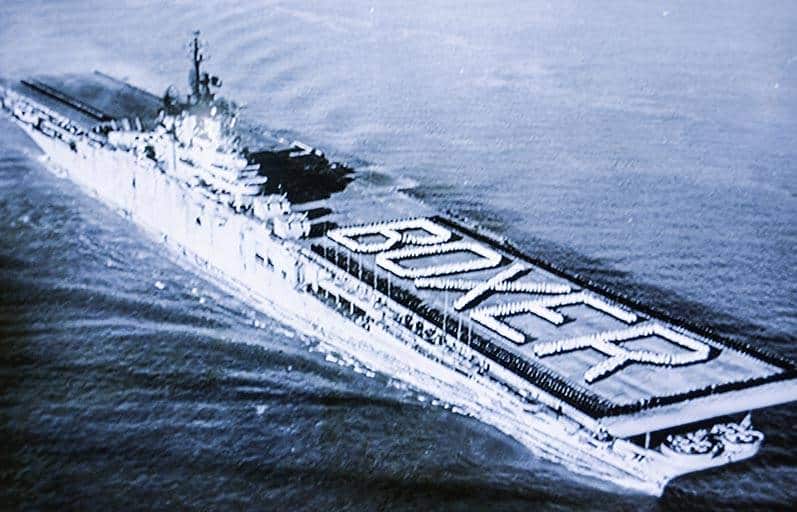U.S. Navy Korean War Elk Grove Village, IL Flight date: 08/09/17
By David Koziol, Honor Flight Chicago Veteran Interviews Volunteer
Wally has been waiting a long time for his Honor Flight. Ever since he heard about the day, he’s had the info posted on his fridge, waiting for the time when Honor Flight Chicago would finally accept applications for Korean War vets.
In June 1948, Wally graduated from Steinmetz High School, and by October he had enlisted in the Navy. “I couldn’t go to college as we didn’t have the money. My dad told me you can’t be a drug store cowboy.” His basic training was at Great Lakes. “I was an Airedale – I wanted to be with aircraft. I went to Millington, TN for three months to learn my trade. I eventually became a structural mechanic.”
By the spring of 1950, Wally was stationed at Alameda, CA. The Fleet Naval Air Station had a baseball team, the only one on the west coast. “I tried out and made it. I got assigned to the gym and FASRon Eight (Fleet Air Support). We were part of a service squadron that repaired all kind of aircraft at Alameda. But all I did for three months was play ball and I thought, boy, if this is the Navy, I’m shipping over! Then, it was June of 1950 and the team went poof.”
“I got assigned to the USS Boxer, which just happened to be in Alameda, its home port. There were only two carriers in the Pacific at that time. The USS Valley Forge went out on a six-month cruise and USS Boxer had just come in.”
“Because the war had started, they loaded up the Boxer with 200 P51 Mustang Air Force fighters, and 600 Air Force guys – we were just a large ferry boat to Japan. We left Alameda with a destroyer on each side, but they had to drop off because they couldn’t keep up with us; we were doing 32 knots day after day. We did a speed run and saw nothing until two tin cans picked us up out of Tokyo bay nine days later. We unloaded and beat our own record of eight days coming back.”
“We were getting ready to go back on another trip, but every time you left the states, you got 7 shots. It was less than a month and I was getting those shots again. I kept telling them “here’s my card, here’s my card!” – but everybody got them. I will never forget that”.
“At the end of August 1950, we took off for Pearl Harbor. We practiced there with the air group for a week or so. I was a yellow shirt on the hanger deck, correcting planes up and down. You don’t park planes – you spot them, every place you park a plane is marked.”
“Finally, we left Pearl and headed west, the Missouri on one side and the Leyte on the other. About two or three days out we hit typhoons. We had planes on the flight deck, and dodged three of them but ran from the fourth one. By the time we pulled into Sasebo in southern Japan, we were two or three days late, and the Missouri and the Leyte were there waiting for us. Within six hours, we got replenished and left again.”
“By the next morning, our flights were getting ready to fly. At 0600 the ‘old man’ came on the horn and said, ‘We are now 250 miles from meeting the 7th fleet. Our planes are now supporting the Inchon landings.’ When we met up with the rest of the fleet, the Valley Forge was there, and a British carrier, all for the Inchon landing.”
“As the years went on, I was on three different cruises with air groups. All we did was go up the Yellow Sea and the Sea of Japan, traveled 600 miles a day, with the fleet. In bad weather, we would replenish; in good weather, we flew. We had almost 80 planes and flew 90 to 100 ground support missions every day. The Navy gave all the ground support for the troops. The Air Force flew high and dropped the bombs, and their Sabre jets were fighting the MiGs.”
“I made three trips in 47 months. All told, I believe there were about 8 different carriers during that 2-year span. We had four carriers and we were only about 50 – 60 miles from the Russian base. The Russians knew we were there as their subs were following us all over the place, but they didn’t bother us. We bombed the North Korean power plants and so forth on the Yalu River.”
“The funny thing was the Boxer was ship number 21, the Bon Homme Richard was 31, the Princeton was 37. We probably had two hundred planes in the air at a time and our pilots were getting confused. Planes came back and would land on the wrong carrier as all they could see was the numbers on the deck. The crews would write messages to the other carriers on the planes using water based paint.”
“On my second cruise, I was a yellow shirt on the flight deck. You would see it all there – planes over the side, planes would hit the side, planes would come in with one wheel or no wheels — all that stuff.”
“In August of 52, I was in the metal shop. The shop was on the fantail, on the hanger deck. We were getting ready for morning flights, and suddenly we heard the fire alarm. There was a fire way up front by the bow. We weren’t sure what happened, but we thought a rocket hit some napalm. I came out of the hanger deck and you couldn’t see. You have all these planes all tied down with wire, so we had a hell of a time walking. There were guys trapped on the hanger deck who were jumping over the side; the tin cans were picking them up. I don’t think we lost any that way, but I think we lost 9 guys in the fire. We fought that fire all day.”
“I had signed up for 3 years, and was down to 30 days, and the first president I every voted for, Harry Truman, extended everyone for 1 year. I always say, thanks Harry. I never went to college but I learned a lot from the Navy. It was my college education. I learned how to get along with people and how to take orders.”
“I got discharged in California and had to go to the draft board when I got home to get reclassified. I met this little gal behind the counter. Here I am 22, just out of the Navy, and couldn’t keep my mouth shut. I asked for a date and 3 or 4 years later we got married.” He was married for 61 and ½ years, until he lost his Marie in 2016.
Wally retired from the telecommunications industry in 1995 at 65. Wally has 4 children (2 sons and 2 daughters), and 4 grandchildren, and they are a very close family. He enjoys fishing. walking the neighborhood and time with his family.
Wally Wienert, we hope you thoroughly enjoy your Day of Honor in Washington. Thank you for your service to your country and to all of us. Welcome Home!






